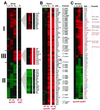The transcriptional profile of early to middle sporulation in Bacillus subtilis
- PMID: 10869437
- PMCID: PMC16670
- DOI: 10.1073/pnas.140209597
The transcriptional profile of early to middle sporulation in Bacillus subtilis
Abstract
Spore formation by Bacillus subtilis is governed by global changes in gene transcription. We used nylon-substrate DNA arrays representing approximately 96% of the predicted open reading frames in the B. subtilis chromosome to compare the pattern of transcripts from wild-type cells with the pattern from cells mutant for the sporulation transcription factors Spo0A or final sigma(F). We found 520 genes whose transcript levels were at least 3-fold dependent on Spo0A but not on final sigma(F), and an additional 66 genes whose transcript levels were dependent upon both regulatory proteins. Two strategies were used to help assign genes to the direct control of a particular developmental regulatory protein. In one approach, we analyzed the effects on global gene expression of artificially producing a constitutively active form of Spo0A during growth. In a second approach, Hidden Markov models were used to identify promoters likely to be activated by Spo0A, final sigma(F), or a third sporulation transcription factor, final sigma(E). In addition to detecting known sporulation genes, we identified many genes of unknown function whose patterns of expression and regulation suggest that they could be involved in sporulation. Disruption of two such newly identified genes, yabP and yabQ, blocked sporulation at a late stage.
Figures




References
-
- Stragier P, Losick R. Annu Rev Genet. 1996;30:297–241. - PubMed
-
- Chu S, DeRisi J, Eisen M, Mulholland J, Botstein D, Brown P O, Herskowitz I. Science. 1998;282:699–705. - PubMed
-
- Iyer V R, Eisen M B, Ross D T, Schuler G, Moore T, Lee J C F, Trent J M, Staudt L M, Hudson J, Jr, Boguski M S, et al. Science. 1999;283:83–87. - PubMed
-
- Kunst F, Ogasawara N, Moszer I, Albertini A M, Alloni G, Azevedo V, Bertero M G, Bessieres P, Bolotin A, Borchert S, et al. Nature (London) 1997;390:249–256. - PubMed
-
- Burbulys D, Trach K A, Hoch J A. Cell. 1991;64:545–552. - PubMed
Publication types
MeSH terms
Substances
Grants and funding
LinkOut - more resources
Full Text Sources
Other Literature Sources
Molecular Biology Databases

